Speech sounds can be examined from two different perspectives. You can look at the physical properties of speech sounds (this is what phonetics is concerned with) and you can also look at how speech sounds behave in a given linguistic system (=language), how they function, where they occur and where they do not, how they turn into each other (this is what phonology is concerned with).
Human speech typically involves a speaker and a listener. The speaker pushes air out of their lungs, manipulates the airflow with their speech organs (glottis, velum, tongue, teeth, lips, etc). How speech sounds are created in this process is the topic of articulatory phonetics. Once the air leaves the speaker’s lips it travels through air as a wave: in some areas between the speaker’s lips and the listener’s ears the pressure of the air is higher, in others it is lower. What these air waves look like for different speech sounds is what acoustic phonetics is working on. Finally, the air waves reach the listener’s eardrums and get converted into neural impulses that their brain can then decipher. The branch of phonetics concerned with such issues is called auditory phonetics. We will only deal with articulation here.
In articulatory terms the main difference between consonants and vowels is that a consonant typically involves an obstruction somewhere in the vocal tract. It is the sound that the movement of the air creates as it passes around or across this obstruction that we call the given consonant.
The production (aka articulation) of a consonant is characterized by the area where this obstruction is formed — this is the consonant’s place of articulation (often abbreviated as POA or simply place) — and the degree of the obstruction (complete or partial, in the latter case narrow or wide, etc) — this is the consonant’s manner of articulation (or simply manner). Some consonants have further characteristic properties, which we will introduce later.
A very precise description of how a given sound is articulated is often unnecessary. It is useful, for example, when a sound is compared to another similar sound in some other dialect or language. In most cases little (sometimes even bigger) differences in the articualtion of sounds has no linguistic consequence. Such differences may go unnoticed, or they may be taken as indication that the speaker has a different social, geographical, etc background.
Places of articulation are anatomical terms, names of organs along the vocal tract from the larynx (where the windpipe branches off towards the lungs) to the lips. Some of these organs are active, others are passive: the active articulators move towards the passive ones. You are encouraged to read this detailed description of the articulators.
The three places most commonly referred to in phonology is labial, coronal, and velar.
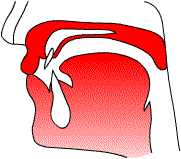
Labial sounds involve one or both of the lips.
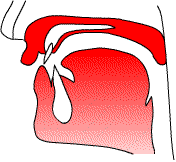
The consonants
A third kind of labial consonant is
Coronal
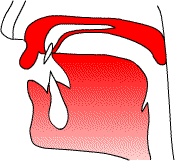
The most common coronal consonants are
Up to this point we have used well-known symbols. This is because the consonants discussed so far are very common, and so the designers of IPA have chosen to represent these sounds by letters from the Roman alphabet. There are less common sounds too, for which the Roman alphabet has no symbols (because Latin did not have these sounds). In this case Greek letters or other solutions are adopted.

The two “th” sounds serve as our first example for such sounds. These sounds are also coronal, more precisely they are dental, sometimes referred to as interdental: the tip of the tongue reaches out to the upper incisors (front teeth) while pronouncing these consonants. The first one occurs in thief
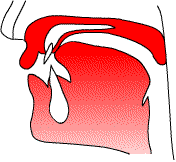
While
The sound represented in English by the letter R is often pronounced as a retroflex consonant, during the production of which the tip of the tongue is curled back a bit behind the alveolar ridge. The “R sound” of dialects and languages is in fact very variable, ranging from labial
The last place of articulation discussed among coronals is palatal.
Behind the (hard) palate the roof of the mouth continues with the soft palate, also known as the velum.
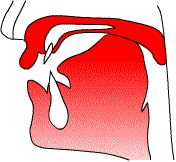
The consonants
In this brief survey we will not discuss uvular, pharyngeal, or epiglottal as places of articulation, because English does not provide us with examples for these sounds. The last (or, if looked at from the lungs, first) place of articulation is glottal.
The sound represented by the letter H in English (of course only when it is not preceded by eg S, as in ship), ie
We have seen that several different consonants share their place of articulation. These differ in other characteristics, eg their manner of articulation. Both
The most common consonants are stops. In them the articulators (the lips, or the front part of the tongue and the alveolar ridge, or the back part of the tongue and the velum or the vocal folds) are pressed together firmly so that no air can escape through this obstacle.
Stops are of two kinds: in
As mentioned, the closure in the mouth is complete in stops (the nose may be open though, in nasal stops). In another group of sounds there is a significant closure, the articulators come into contact, but there are gaps between them through which the air can escape. Because of the narrowness of the passage between the articulators, the airflow is turbulent, which we perceive as noise. Sounds produced in this manner are called fricatives because of the friction of the air characterizing them. As already hinted at,
It is useful to distinguish two types of fricatives: the more noisy sibilants (ie
The affricates of English are
Fricatives are produced by a fairly narrow constriction between the articulators. By pulling the articulators more apart, a larger gap remains between them. Sounds created in this way are called approximants. Of the consonants we have discussed so far,
You may have noticed that the difference between fricatives and approximants is not very great, it depends on the degree of the constriction between the articulators. In fact,
If the constriction between the articulators is maximally wide, vowels are pronounced. In this sense, vowel is also a manner of articulation, but we will discuss vowels separately.
A category partly cross-cutting the manners of articulation above is lateral.
It has already been mentioned that “R-type” sounds are very diverse, ie may be pronounced in several different ways, yet these differences are rarely distinctive in a given language. The most common English rhotic is an alveolar or retroflex approximant,
The lateral
The two approximants
Two very basic sound categories have to be mentioned here. One of them, the best known one, is consonant vs vowel. These two types of sound cannot always be distinguished physically. That is to say, if you hear a sound, you cannot always tell whether it is a vowel or a consonant. In English (like in many other languages) the glides
The other distinction is between obstruents and sonorants. Plosives, affricates, and fricatives are obstruents, nasals, approximants, and vowels are sonorants. One common feature in English (and in Hungarian) of obstruents is that they come in pairs: there are two contrasting consonants at each place for each manner. That is,
We already know that the larynx is at the top of the windpipe, containing the vocal folds. The vocal folds can block off the windpipe so that food or liquids intended for the stomach do not get diverted into the lungs.

In the diagrammes above you can see schematized images of the glottis. The two black triangles are the arytenoid cartilages, which govern the vocal folds (the edges of which are represented by the vertical line(s) in the middle).
A glottal stop (
The pairs
Airstream mechanisms are discussed here only for completeness’s sake. During speech production air must be moving through at least part of the vocal tract. The movement of air is commonly egressive (ie outward), but it may also marginally be ingressive (ie inward).
The initiator of the movement may be the lungs (this is pulmonic
| out | in | |
|---|---|---|
| lungs | ✓ | ✗ |
| larynx | ✓ | ✓ |
| velum | ✗ | ✓ |
The three initiators may combine with the two airstream directions in a limited way, as shown in the chart to the right. The pulmonic airstream can only be egressive, that is, air can only move out of the lungs. It is true that we can speak while inhaling the air (try it!), but this is mechanism is not normally used by any human language. English and Hungarian have only pulmonic egressive sounds (lungs, out).
Pressure can also be created by closing the glottis and moving it upwards — this results in so called ejectives (larynx, out). Vacuum can be created by moving the glottis downwards, in which case it is vibrating — the sounds so produced are implosives (larynx, in). Finally humans may rarefy the air by moving their tongue downwards while closing the gap at the velum by the back of the tongue. These sounds are velaric ingressive, more commonly known as clicks (velum, in).
clicks are fun!
Here is a chart of the nonpulmonic consonants, you can click on the symbols and listen to how these consonants sound. You can also find the IPA symbols for these consonants here. (You don’t have to learn these symbols!)
Up to this point we have discussed almost exclusively consonants that had a single place and a single manner of articulation. There also exist consonants that have two places, ie two simultaneous closures in the oral tract. The best known example for such double places is labiovelar. We have already got to know the labiovelar approximant,
In some cases the two places are not simultaneous, but a secondary articulation accompanies follows or precedes the primary place. For example, velars may be labialized:
Affricates may also be considered as having two articulatory gestures: two manners of articulation, stop+fricative. But, as we have seen, affricates can also be taken to be slowly released plosives.